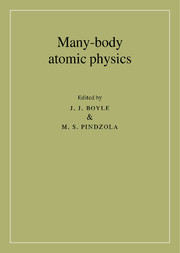Book contents
- Front Matter
- Contents
- Foreword
- Contributors
- Preface
- Acknowledgements
- Part 1 ATOMIC STRUCTURE
- 1 Development of atomic many-body theory
- 2 Relativistic many-body perturbation theory for highly charged ions
- 3 Parity nonconservation in atoms
- Part 2 PHOTOIONIZATION OF ATOMS
- Part 3 ATOMIC SCATTERING: A. General Considerations
- Part 3 ATOMIC SCATTERING: B. Low-order applications
- Part 3 ATOMIC SCATTERING: C. All-order applications
- Appendix: Units and notation
- References
- Index
1 - Development of atomic many-body theory
Published online by Cambridge University Press: 22 September 2009
- Front Matter
- Contents
- Foreword
- Contributors
- Preface
- Acknowledgements
- Part 1 ATOMIC STRUCTURE
- 1 Development of atomic many-body theory
- 2 Relativistic many-body perturbation theory for highly charged ions
- 3 Parity nonconservation in atoms
- Part 2 PHOTOIONIZATION OF ATOMS
- Part 3 ATOMIC SCATTERING: A. General Considerations
- Part 3 ATOMIC SCATTERING: B. Low-order applications
- Part 3 ATOMIC SCATTERING: C. All-order applications
- Appendix: Units and notation
- References
- Index
Summary
Hugh Padraic Kelly was a pioneer in many-body perturbation theory (MBPT) and its application to atomic systems. He was the first to apply the new diagrammatic technique, developed mainly in field theory and nuclear physics, to problems in atomic physics. He introduced many new ideas, which have been widely used in different areas. In the first years, his work was concerned with the correlation energy of simple atoms and with the hyperfine interaction. In the last two decades he concentrated his efforts on the photoabsorption and photoionization problem, a field where he played a dominant role for a long time. In this chapter I shall give a brief review of the development of atomic MBPT and of the role played by Kelly. I shall also discuss later developments, including relativistic MBPT and QED calculations. I do not intend to give a full account of Kelly's work in different areas, since much of that will be covered in other chapters.
Background
Perturbation theory, which has been used for a long time in mathematical physics and astronomy, was introduced into quantum physics shortly after the advent of quantum mechanics in the 1920s. The most well-known of these schemes are the Rayleigh-Schrödinger and the Brillouin-Wigner expansions. In principle, these schemes can be used to any order, but they are, in actual atomic and molecular applications, almost prohibitive beyond fourth order, which may be insufficient to achieve the desired accuracy in many cases.
- Type
- Chapter
- Information
- Many-Body Atomic Physics , pp. 3 - 38Publisher: Cambridge University PressPrint publication year: 1998
- 14
- Cited by



